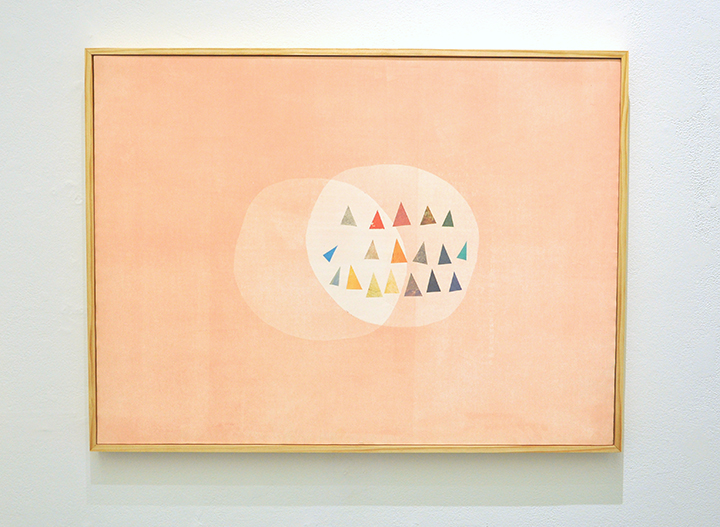 Mary Gordon, “Little Dance,” 2020. Monotype with chine collé mounted in wood frame, 22 x 30 inches.
Mary Gordon, “Little Dance,” 2020. Monotype with chine collé mounted in wood frame, 22 x 30 inches.
MFA Candidate Spotlights: Christina Foard, Laurel Fulton, Alec Kaus and Mary Gordon
This week we are spotlighting four of this year’s Lamar Dodd School of Art master of fine arts degree candidates. Though the Georgia Museum of Art is currently closed to the public, the museum has shifted the MFA candidate exhibition online.
Christina Foard
When Christina Foard, 53, relocated to Athens, Georgia, in 2014, pursuing a master of fine arts degree became an option after her 13 years as a single parent. Though Foard is from Terrace Park, Ohio, she describes Athens as her permanent home. She chose to pursue her MFA at the Lamar Dodd School of Art because she felt the program could “facilitate significant growth” in her work. Foard earned her undergraduate degree from the University of Cincinnati.
Foard leans toward painting as her medium but is currently “straddling” sculpture as well. She said she is starting to paint on a variety of different objects and is moving toward “installation and environments with painted surfaces.”
“In the Cacophony of Voices, I Only Remember What Wasn’t Said” is the name of her installation as part of this year’s MFA show.
“My installation consists of wall and floor-based objects made of painted wood, wire, felt, foam and silk, each engaged in competition for attention through positioning, scale, color and layering,” said Foard.
During the three years that Ford was earning her master’s degree, she recalls her family discussing topics in the news at the kitchen table. Her work illustrates her response to those voices.
My thesis installation addresses the autobiographical complexity of familial communications at this time of heightened partisan polarity and sensitivity,” said Foard.
This body of work was made entirely in 2020, and Foard credited the hearing for Brett Kavanaugh’s nomination to the Supreme Court as the “tipping point” for it.
“Aside from the chatter of what is said, many works in the installation address the role silence has played in condoning sexual abuse or condoning political abuse of power within our current leadership,” said Foard.
Because the exhibition has moved to an entirely online format, Foard said a lot of the subtilities will be lost through the digital translation. She said that the immersive scale of her work in relation to the viewer does not translate well on an online platform, but she is grateful to the museum for moving the show online.
“I think the online format might reach a more inclusive and expansive audience than the typical museum opening,” said Foard.
In response to the COVID-19 pandemic, she believes “this is a profound moment to see the world through other people’s vantage points.”
“Covid, as scary and tragic as the news indicates, is requiring us to slow down and get to the core of ourselves, our homes, our relationships, even our life trajectories,” said Foard. “Art juxtaposes interpretations and translations of life experiences through specific lenses.”
After graduation, Foard plans to stay in Athens and make art full time in her studio. She hopes to expand her internet representation and her gallery. Currently, she is working on a community project focusing on resilience called “Imagination Squared.”
Laurel Fulton
Laurel Fulton, 30, from Louisville, Colorado, is one of the 12 artists graduating with her master of fine arts degree from the Lamar Dodd School of Art this May. Fulton holds her bachelor of arts in photography and art education from the University of Northern Colorado.
Fulton describes herself as a metalsmith and an image maker, using traditional and contemporary techniques when creating her art. That includes “soldering, forming, riveting, acrylic fabrication, plating, powder coating and leather work,” said Fulton. Once she has created these objects, she takes pictures of how they “interact with the body.”
Before pursuing her MFA, Fulton taught high school painting and drawing in Colorado for several years. Because she didn't have much time for her own creative endeavors, she took a year-long artist's residency at the Pocosin School of Art and Fine Art in Columbia, North Carolina. When looking into graduate programs, she spoke with Mary Hallam Pearse and Demitra Thomloudis in the jewelry and metals area of Lamar Dodd. Fulton knew right away she wanted to study under them and credited them as the reason she studied here.
“Much of my formative research was done on medical apparatuses and instrumentation. I became fascinated with the aesthetics of healing; the funnels, tubing, straps and sterile surfaces,” said Fulton. “This imagery informs many of the forms and surfaces I chose for both my images and objects.”
Fulton states that her work speaks to how two people communicate and how the interaction is always “ultimately flawed.”
“No matter how well we think we communicate, there is always a difference in interpretation from one person to the next,” said Fulton.
Because the exhibition is now online, viewers have limited viewing. Fulton said that the audience can no longer interact with her work and cannot observe its subtle nuances. Fulton said the scale will also be affected because they were printed very large for the physical exhibition.
During the COVID-19 pandemic, Fulton encourages people to rediscover their own creativity and support the creatives in their community.
“I encourage people, if they can, to reach out to the artists in their community and support them in some way. Either through purchasing some of their work or promoting them to others,” said Fulton.
After graduation, Fulton hopes to continue teaching.
Alec Kaus
Alec Kaus, 27, received a bachelor of arts degree in studio art from the University of Nebraska–Lincoln. Since 2017, Kaus has been pursuing a master of fine arts degree in studio art from UGA.
On Kaus’ website, he describes his work as moving between the fields of art history, art criticism, curation and photography. He states that his research interests include “the role history, archives and folklore play in constructing narratives about our collective past, present and future.”
Kaus stated that his style of art could be described as a “poetic or lyrical personal narrative.” He also said that he is always photographing because his work is his life and his life is his work.
Kaus attributes the inspiration of his art in the MFA exhibition to being separated from his partner and navigating his final years of graduate school without him. He says the theme of the work is “navigating a long-term relationship in 2020 and imagin[ing] what love, longing, desire and loneliness look like.”
“My art and my photography have always been my form of escape and processing anything I am going through at the time,” said Kaus. “I really fell in love with photography when my grandpa died when I was in high school; since then I have viewed photography as a therapeutic tool.”
In his work, Kaus uses scale and grouping to facilitate an emotional response in a viewer. He said he is not concerned about portraying a narrative to the viewer, but he wants them to see a lot of images together and feel a mood from it. Because the exhibition has moved to an online platform, those qualities get lost in translation.
“What I feel gets lost in the online exhibition is one, the physical scale of the images and being able to see multiple images at once rather than clicking or scrolling through,” said Kaus.
Kaus believes that art is more important now in the era of 24-hour news and the global pandemic.
“Photography allows me this space to create my own world and dictate what goes on and how things look, what I'm looking at and how I'm feeling,” said Kaus. “I think as a viewer too, art can really take you outside of reality and into all different worlds. That's why I feel art is important right now.”
In regard to the future of his art, Kaus described that he has always thought of his work as building to something larger. After graduation he will be moving to Texas to pursue photography teaching jobs.
Mary Gordon
Mary Gordon, 29, was born in Weinheim, Germany, but calls Manhattan, Kansas, home. Gordon earned a bachelor of fine arts degree in painting and printmaking from Kansas State University. In May, she will graduate from UGA with a master of fine arts emphasizing printmaking and book arts.
On her website, Gordon writes that she “fuses fragments of prints through collage and mixed media to explore her natural environment, everyday interactions and overlooked happenings.” She is drawn to piecing remnants together, either using paper or other materials, because it allows for control and spontaneity. She feels her work is in between abstract and representational.
“My work circles around the question can one play with places, like places that are most familiar to us. Can we zoom in and zoom out and look at them from different angles, that's what I'm thinking of when I'm creating,” said Gordon.
Where Gordon grew up in Kansas, she said there was all this open space and she could see the horizon line wherever she went. The landscape of Georgia it feels very different and very closed in. Gordon said she doesn't try to re-create the places from her childhood, but feels "they are ingrained in [her] subconscious and come out in what [she] creates.”
In regard to her exhibition work being moved to online, Gordon states her art is meant to be experienced in person and looked from up close or far away. Gordon emphasized there are subtle textures and features that can only be experienced in person; you can't get a true sense of style online.
In the time of the COVID-19 pandemic, Gordon said that engaging in other people's ideas, talents and passions takes us outside of ourselves.
“Art and music pull us outside of ourselves and make us look outward,” said Gordon.
After graduation, her hope is to continue creating and keeping up her studio practice by routinely practicing printmaking.
